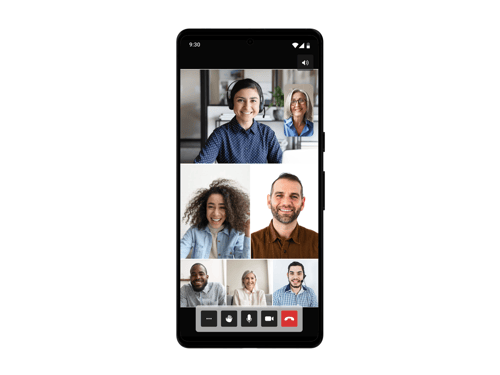How AI is used to enhance video conferencing
Artificial intelligence (AI) has long been present in the world of video conferencing and is employed (and continually advancing) in various ways to improve and enhance the user experience. This includes:
- Driving productivity.
AI supports enhanced in-meeting collaboration through real-time translation, speech-to-text functionality, meeting transcripts, and even facial recognition to identify participants.
- Enhancing quality.
AI is used to improve the video quality during your meeting, frame faces correctly, reduce background noise, and other almost unnoticeable tweaks that raise the quality of the user experience. Pexip Infinity 33 introduces AI-powered Adaptive Composition layouts and audio background noise reduction.
- Optimizing management and operations.
AI is used to help optimize bandwidth and computer usage during video meetings. It’s also part of managing deployment, for example, ensuring a good match between the number of meeting participants in the selected meeting room.
- Specialist and custom applications.
This is when AI is used for highly specialized purposes in regulated industries like healthcare, finance, judicial, and government organizations where compliance with privacy and regulatory demands are top priorities. It may involve custom workflows such as AI-driven video applications for first responders, as one example.
Private and secure AI for specialist and custom video conferencing applications
It’s in the specialist and custom applications arena that Pexip is actively exploring the next frontier of AI in video conferencing. Our goal is to enable anyone to communicate live over video with anyone, across distances, borders, and now, even languages as well – most privately and securely – meeting the needs of even the most highly regulated industries.
In the use case of AI as a universal translator, AI forms a treasure trove of valuable data. Data generated from conversations demand strict privacy and security measures, and so does the data surrounding those conversations. This data is called “metadata”, and it identifies information such as who is talking to whom, how frequently, and where they are located.
Why is it so important to keep video conferencing metadata private and secure?
Metadata is like an envelope that contains a letter inside. The postal worker cannot read what’s inside the letter, but they can see what’s on the envelope to deliver it to the correct destination. This same principle applies to messages sent over the internet. While the conversation itself (over video) is encrypted, the metadata can still reveal significant and often telling information.
When you view metadata across a population, for example, you may start to see patterns and identify groups of people who are communicating with each other. You can also glean information about potential events due to a flurry of communication activity between parties. This could potentially reveal merger and acquisition activity, for example, or the forming of national alliances during a time of geopolitical tension.
Which organizations need to think specifically about security and privacy in AI?
Best practices for implementing private and secure AI for video conferencing
- Secure software development.
From a software engineering standpoint, secure software development is essential to secure and private AI. To avoid a host of new vulnerabilities being discovered almost daily, seek software that is built in a secure manner from the ground up and that embraces automated testing. Every building block must have a known provenance, otherwise you open yourselves up to increased vulnerabilities. Your AI vendor should operate the system in a secure location, in a secure manner, and under the appropriate jurisdiction to ensure proper control of your data and the often overlooked but very important metadata.
- Data control.
Self-hosting your own AI data and metadata means that it remains under your own control. On the extreme side of this is hosting on an air-gapped network, which means the complete disallowing of access. This can be a quite drastic measure taken to protect critical infrastructure. On-premises or private or sovereign cloud hosting are less extreme options that give organizations the desired control over where the data is stored and where it goes.
- Compliance.
There is a maze of security certifications and compliance requirements for each country and region. For example, in the European Union there is the EU AI Act that requires AI products to be classified according to their risk level – with specific requirements to match the level of risk entailed. Learn how to address AI compliance concerns in 3 strategic steps.
How self-hosting helps resolve AI security concerns
Over the past few years, cyber threat actors have succeeded in shutting down hospitals and police departments, and infiltrating critical infrastructure such as power grids, dams, and even nuclear facilities. These are examples of critical services to society, which cannot run the risk of breach. For this, self-hosting your AI data and metadata is one way to keep it under your own control.
Self-hosting your AI video solution on-premises is a good option for organizations with strict privacy and security requirements. This often includes government, healthcare and other organizations that require control over their data – particularly when it comes to personal information.
Self-hosting on-premises also meets data sovereignty requirements, as it allows organizations to keep the data within a certain jurisdiction. It also helps to minimize external risk exposure, as the video conferencing system remains behind the organization’s own firewalls and security measures.
Here are three potential hosting approaches to maintain full control of your AI data and metadata:
- Air-gapped.
Deploying AI solutions on an air-gapped network gives users the ultimate assurance around data control and sovereignty. This type of deployment is 100% disconnected from an outside network to ensure complete security.
- On premises (not air-gapped).
By hosting the AI solution on premises on the organization’s own equipment, they can maintain full control, on-site, of all data generated. Some organizations are also taking a hybrid approach, combining on-premises hosting with private or public cloud services depending on their need and the sensitivity of AI data they generate.
- Private or sovereign cloud.
Organizations may choose to deploy secure AI in a self-hosted and self-managed cloud solution, enabling them to enjoy the scalability benefits of a cloud service while still meeting strict privacy and security requirements.
Privacy and security in the AI regulatory landscape
There are many local, national, and sometimes regional regulations that may impact how you store and share data, especially when it comes to data privacy and protection requirements such as GDPR in the EU. Be sure to check your local requirements to stay compliant.
Here’s a short overview of some key AI regulations impacting organizations today.
EU’s AI Act
The AI Act requires AI products in Europe to be classified according to risk. On one end, unacceptable risk, representing forbidden uses of AI, such as systems that run real-time, biometric identification in public, or workplace emotion monitoring. High risk classification includes self-driving cars or judicial and medical systems in which regulatory oversight is needed. Then on the lower end of the risk spectrum are AI applications such as customer service chatbots, which come with certain transparency requirements and obligations to be approved usage. For example, it may be required to disclose whether the user is interacting with a chatbot versus a human.
The United States’ AI Bill of Rights
The AI Bill of Rights in the US promises the right to safe and effective AI systems with algorithmic discrimination protection. This means that individuals should not face discrimination from biased algorithms or AI models. This Bill of Rights also extends into privacy protections, detailing the protection of individuals from abusive data practices and giving users the opportunity to control how their personal data is used.
AI ethical implications
While AI represents new opportunities and advancement, it is not without ethical dilemmas. Here are some of the key ethical challenges faced with increased used of AI in video conferencing communication:
- Biases.
One of the major failures in AI is when the system reinforces social, racial and gender biases. This doesn’t mean that the algorithms themselves are biased, but rather that the AI training data often reflects the world we live in – a world still replete with bias. This gives rise to a host of ethical issues during, for instance, live translation in a video conference. One example of this bias is the default male problem. This is when the translation defaults to male pronouns, which may erase the woman entirely from the conversation. One example of this is when the system translates “doctor” to male and “nurse” to female based on the pronouns used.
- Augmenting jobs.
We are at the beginning of another industrial revolution, and in this shift, AI will augment some existing roles, and create new roles that we haven’t even discovered yet. Some professions will be displaced by this technology, which requires thoughtful and well-considered approaches.
- Over reliance on imperfect technology.
We must proceed with caution when it comes to the context in which AI technology is applied. For example, an over reliance on AI technology could be problematic in a situation of incorrect translation – which may lead to dire cultural or political implications.
How to use AI in today’s complex and varied device landscape
The myriad devices in circulation today often come with incompatible walled garden (closed) ecosystems – especially in the world of video conferencing. In this landscape, you find Teams, Zoom, WebEx, FaceTime and others, and the reality is that many people are running these applications on older devices. The AI challenge that arises is whether an eight-year-old iPad can run the heavy workload required for an AI-enhanced video conference with live speech-to-speech translation, for instance.
This challenge has been addressed by Pexip, as our approach is to do all the AI heavy lifting in the network without burdening the end-user devices. With this method, AI technology can be democratized and made available to all, regardless of the type of device they use or the situation they are in. Pexip calls this server-side transcoding, and it enables a cutting-edge AI experience no matter the device in use.
Why does server-side vs client-side matter for video meetings?
Your checklist: How to implement secure and private AI
In your journey to bring AI into your video workflows, we have 3 key suggestions for selecting your AI vendor and partner:
- Choose a product that is built securely from the ground up, to comply with strict security standards that may be applicable.
- Select an AI vendor that takes an ethical approach to AI adoption.
- Ensure that your AI vendor operates your system in a secure location, in a manner that complies with the local jurisdiction and ensures your full control over the data and metadata.
Pexip and Nvidia collaborate to enable private AI translation for secure video meetings
Today, there is a large, untapped market for AI services that can benefit society. Soon, AI will enable us to seamlessly translate between languages in real-time over video conferences, regardless of systems and devices. Keeping this data safe is paramount, as is compliance with relevant regulations and requirements related to use of AI and all the information generated as a result.
This was the starting point for Pexip and Nvidia’s collaboration. Together, Pexip and Nvidia are building a foundational platform for secure and private AI services – bringing rich video and audio data into one place, securely. Pexip works closely with Nvidia to enable both live captioning and translation services as well as video quality enhancements using Nvidia’s Maxine and Riva technologies.
How NVIDIA AI supports natural language process and real-time translation in video meetings
Enabling AI for secure and custom video environments
The future of AI-powered video conferencing promises much clearer and richer communication, removing language barriers and stimulating a more connected world.
Learn more about Pexip’s private AI journey here. Secure and private AI | AI-powered video conferencing | Pexip
- Private AI
- Secure Meetings





